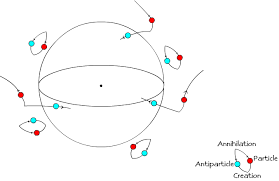Posted by Pranav Kakhandiki | Jun 20, 2018, 11:00:00 AM
What exactly is a black hole? Is it a type of star? How big are they? Why are they called “black holes”?
A black hole is a region of space which has such an intense gravitational field, that not even light can escape it. They are some of the strangest and most interesting objects found in space. Albert Einstein was the first person to predict the existence of them, using his general theory of relativity. The name “black hole”, was given by John Wheeler in 1967, although the first one wasn’t discovered until 1971.

Formation
So how do black holes form? They are created when center of a massive star collapses. This happens when the gravity on themselves is greater than the external pressure caused by temperature. Not all collapsing stars turn into black holes, however. A black hole is determined by the Schwarzschild radius. If the radius of the collapsed star is smaller than the Schwarzschild radius, then it is officially considered a black hole. The event horizon is defined as “the point of no return”, and is a sphere with a radius the same size as the Schwarzschild radius. Once an object passes the event horizon, it can’t escape the gravitational pull of the black hole. Technically speaking, anything can become a black hole if it becomes dense enough. For the Earth to turn into a black hole, it would have to be compressed until it had a radius of 8.7 millimeters! At the center of a black hole, there lies something called a singularity. A singularity supposedly has zero size and infinite density. If an object were to fall into a black hole, then as it approached the singularity, it would become “spaghettified”, due to increasing gravitational pull on different parts of the object.
Escape Velocity
The escape velocity of an object is the minimum velocity which an object needs to escape the gravitational pull of a mass. The equation of escape velocity can be derived by setting the equation of Kinetic energy equal to the gravitational pull of the mass on the object. Doing this, we arrive at the following equation:

If the mass of an object was big enough so that the escape velocity exceeded the speed of light, we get a black hole. This is how they got the name “black hole”, as not even light can escape their gravitational pull!
Temperature of Black Holes
What is the temperature of a Black Hole? Is it absolute zero? Are they infinitely hot? To answer these questions, we must consider interactions between particles and antiparticles. An antiparticle is defined is the “opposite” of a particle, and is the antimatter counterpart of a particle. Think of it as the difference between an electron and a positron. Particles and Antiparticles are created in random places within the black hole, due to Heisenberg’s uncertainty principle.

They often “cancel” each other out, but sometimes the pair separates, making the black hole seem like it’s radiating. This radiation can be used to determine the temperature of a black hole, which is defined by the following equation(Where ‘kB’ is Boltzmann’s constant, and ‘h’ is Planck’s constant):

Strange Evaporation Paradox
So if a black hole really radiates, then wouldn’t it lose mass? And using the equation we derived above, as temperature is inversely proportional to mass, then the temperature would increase. If temperature increases, then the black hole would radiate even more, losing more mass. This is the strange evaporation paradox. Strange evaporation doesn’t actually occur, as it would allow black holes to exist for a limited amount of time. It doesn’t occur because the temperature of space near black holes is greater than that of black holes. This allows the space near the black hole to add energy to the black hole, which then adds mass(via E=mc^2).
What defines a black hole?
Two points define a line. Three points define a plane. What defines a black hole? In other words, what quantities of a black hole would you have to know to figure out exactly what it looks like? Three quantum numbers define a black hole: M, J, and Q. These stand for Mass, Angular Momentum, and Charge.
If you enjoyed reading this article, consider subscribing to TheRealSciBlog to check out more cool articles about emerging topics in science!



Wow really interesting! I want more articles like this!
LikeLiked by 5 people
Really amazing blog site. I look forward to learning more!
LikeLiked by 3 people
Very insightful! I learnt a lot more about black holes than I thought I knew!
LikeLiked by 3 people
This is an interesting post, but Albert Einstein was not the first person to predict the existence of black holes. In 1783, John Michell conjectured that there might be an object massive enough to have an escape velocity greater than the speed of light. In 1796, Simon Pierre Laplace described the idea of massive stars from which no light could escape.
LikeLiked by 2 people
Thanks for the feedback! I’ll make sure to change that.
LikeLiked by 3 people
I’m curious. For a black hole to have temperature, wouldn’t there need to be particle movement? And, at the very center, is anything really moving?
LikeLiked by 2 people
The antiparticles and particles move, causing the black hole to radiate, thus having a temperature. The temperature is still quite close to absolute zero.
LikeLiked by 3 people
Thank you for an intersting post!
LikeLiked by 2 people
Thanks!
LikeLiked by 2 people